
Sweden - Trams (not incl. Stockholm)
For a full scale picture, please click on the picture shown !
Trams of Norrköping
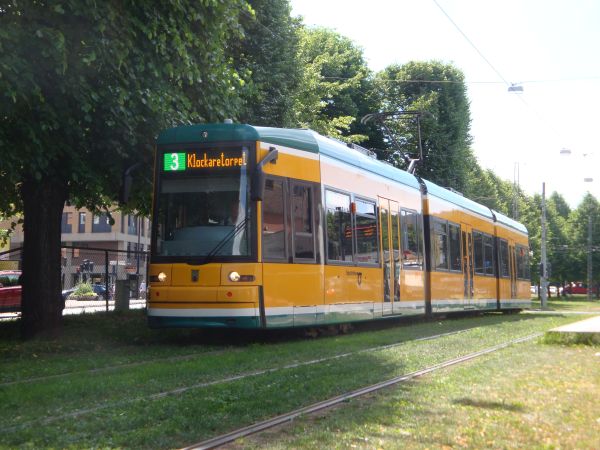
This section of the archive shows trams from the smaller cities in Sweden, but
NOT trams from the Stockholm area. Trams from the Storstockholm area are all included in the SL (Storstockholms
Lokaltrafik) section.
Our first picture shows a Flexity Classic from Norrköping. They have drivers' cabs at both ends and
doors on both sides.
Picture 29.6.2010 by Sanna Siissalo.
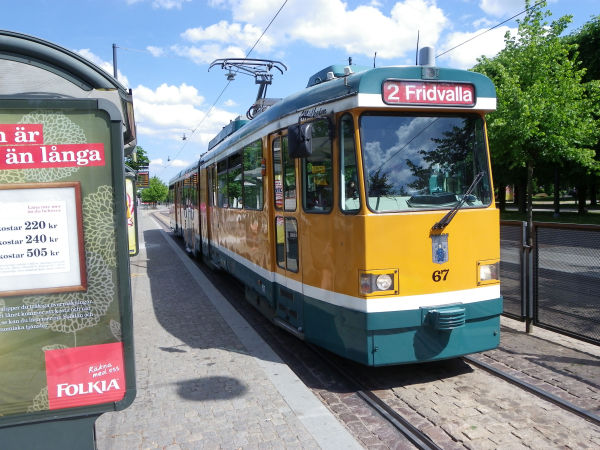
Norrköping has two tram lines, the red line 2 and the green line 3. There are two types of trams in active use. The first
picture of this section above shows the newer Flexity Classic trams and this one is the older type M97. It is an old Düwag
bought used from Germany, but it is now so heavily modified and modernised that it is even hard to recognise as a Düwag
any more. The whole front part is new, in the middle there is a wholly new low floor section and all the inside fittings
and furnitures are totally new. It's mainly the old typically Düwag style folding side doors that reveal that this is
actually a 1960s style Düwag.
Picture from Norrköping main railway station 29.6.2010 by Ilkka Siissalo.
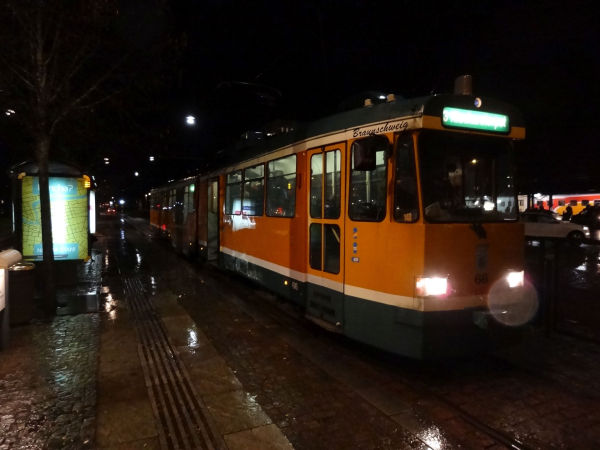
Another picture of an M97 Düwag of Norrköping, but on a dark and rainy night.
Picture from Norrköping main railway station 15.11.2013 by Ilkka Siissalo.
Västtrafik - Trams of the city of Göteborg (Gothenburg)
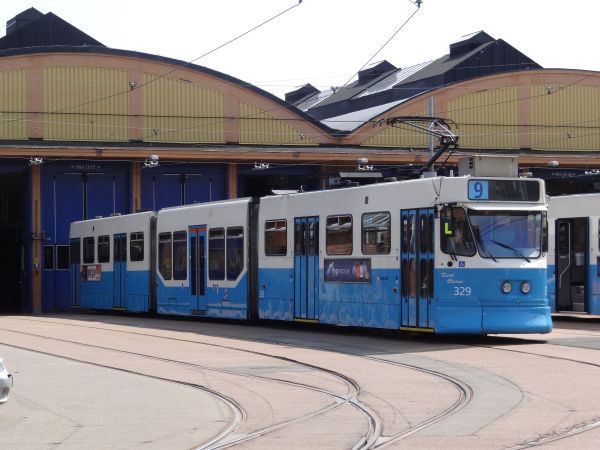
A Göteborg (Gothenburg) class M31 tram by its depot. These trams were built by Mittenwalder Gerätebau in Germany 1998-2003
out of older Asea trams of the type M21. Note the new low floor middle section with its new doors that contrast with the old
Asea built folding doors.
Göteborg has the largest tram network of all the Nordics.
Picture by Ilkka Siissalo 12.7.2013.
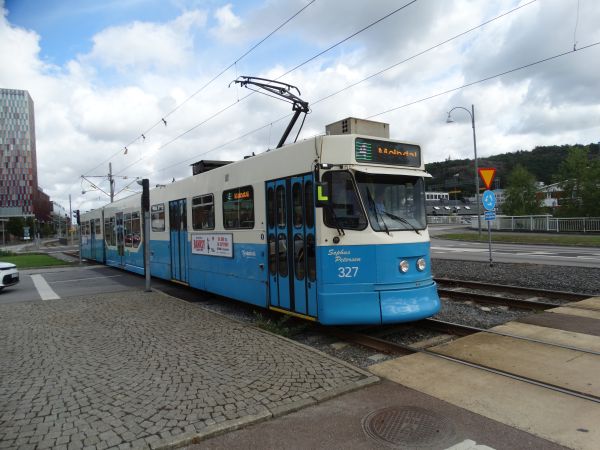
An M31 tram, that is an old M21 Asea tram with a new low-floor middle section by Mittenwalder Geträtebau. Still going strong.
Picture from tramstop Lackarebäcken 7.7.2023 by Ilkka Siissalo.
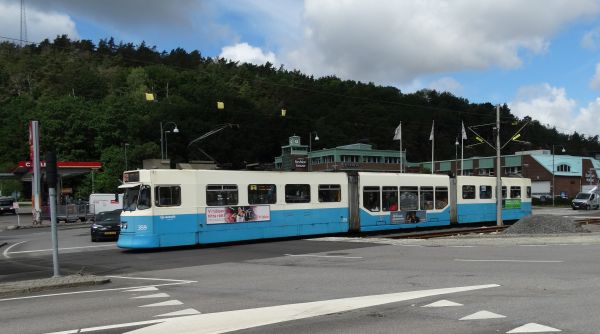
A similar M31 tram but now seen from the other side.
Picture from tramstop Lackarebäcken 7.7.2023 by Ilkka Siissalo.
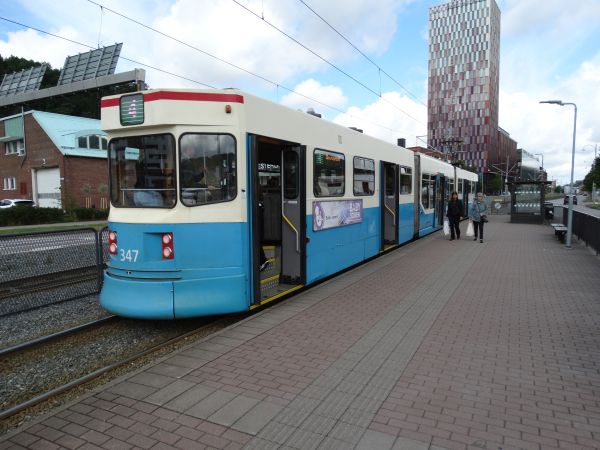
Yet another M31 tram, now seen from behind with its doors open. The old parts which stem from and old Asea tram are really high-floor.
Picture from tramstop Lackarebäcken 7.7.2023 by Ilkka Siissalo.
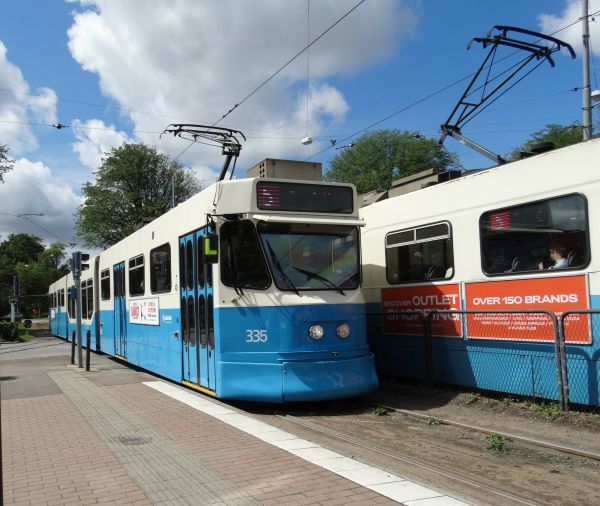
Two M31 trams meeting.
Picture from tramstop Sankt Sigfrids Plan 7.7.2023 by Ilkka Siissalo.
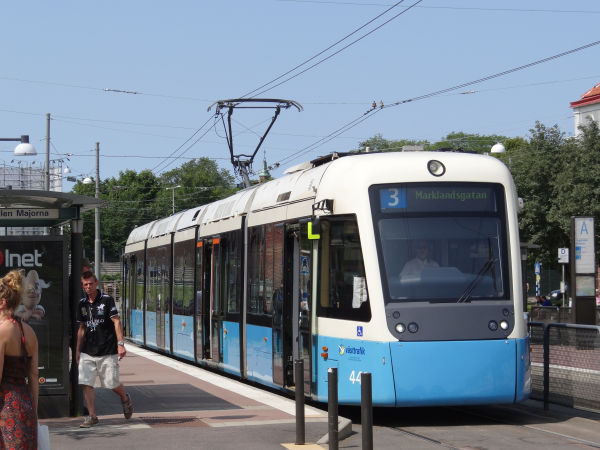
Göteborg's class M32 tram. It is of the Italian Ansaldobreda type Sirio. They were ordered in two series up till 1999.
Göteborg's city and Västtrafik have been far from happy with these trams, which have proven to be totally unreliable
and also are already now suffering from serious corrosion problems. Göteborg has had lengthy legal fights with Ansaldobreda,
whose reputation is badly ruined not only because of these wagons, but also -and more notably- by the total failures of the
Dutch and Belgian V250 "Fyra" trains and the Danish IC4 trains. 2016-18 Göteborg ordered from Bombardier new trams in
order to get totally rid of these Italians.
Picture by Ilkka Siissalo 12.7.2013.
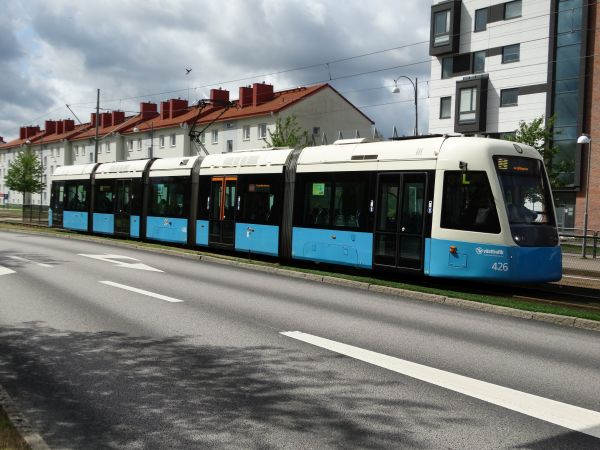
Another one of the Ansaldobreda Sirio M32 trams, now as a full side view. The Swedes have in the meantime been able to lengthen
the expected lifetime of these trams by putting really a lot of work into them. They are by no means reliable even now, but not
all the time broken either. And Ansaldobreda is now bankrupt since a long time, so the Swedes do not get any support from the
manufacturer
Picture of an Ansalsobreda Sirio M32 tram by the tramstop Lackarebäcken by Ilkka Siissalo 7.7.2023.
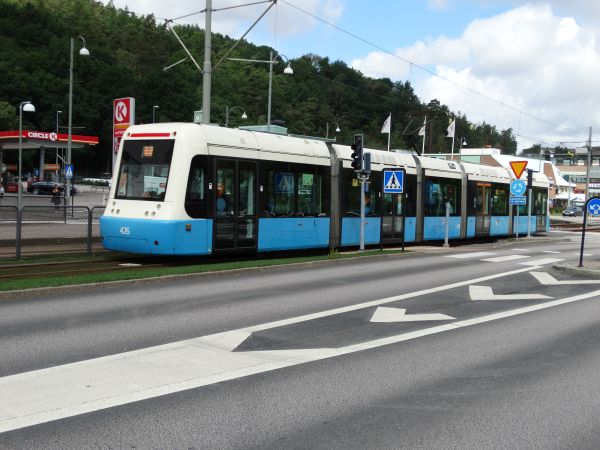
From behind the Sirio M32 trams look a bit odd, like buses.
Picture of an Ansalsobreda Sirio M32 tram by the tramstop Lackarebäcken by Ilkka Siissalo 7.7.2023.
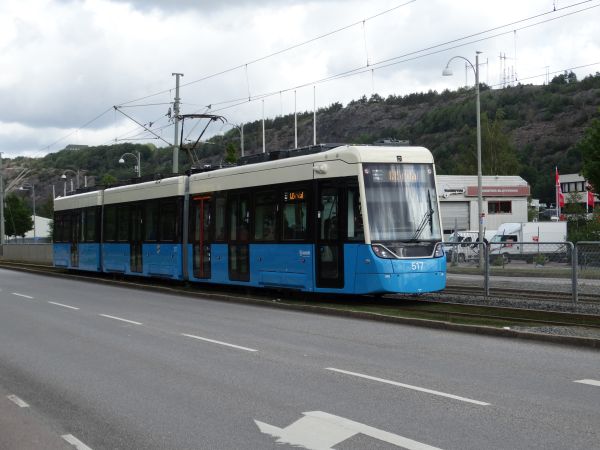
After Västrafiken got totally fed up with Ansaldobreda's lousy quality, they made a decision to buy new trams elsewhere to rapidly
replace the Ansaldobreda Sirio trams. There was a new public tendering which was won by Bombardier Transportation and Vossloh Kiepe of Germany
with their standard tram type Flexity. New trams were delivered 2019-2023. There are now actually three distinct types of these new low-foor
trams in Göteborg. One version has a driver's cab at both ends (type B) and doors on both sides, then another version looks like this (type A),
being a normal single direction tram and yet a third version is similar, but longer, type 33C. The C-type trams are 45 metres long. Types
33A and B are 33 metres long. This one is a 33A.
Picture of an M33A tram by the tramstop Lackarebäcken by Ilkka Siissalo 7.7.2023.
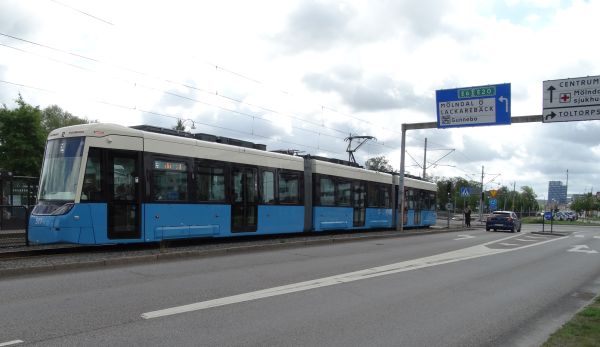
The same type 33A tram as above but now seen from behind.
Picture by the tramstop Lackarebäcken by Ilkka Siissalo 7.7.2023.
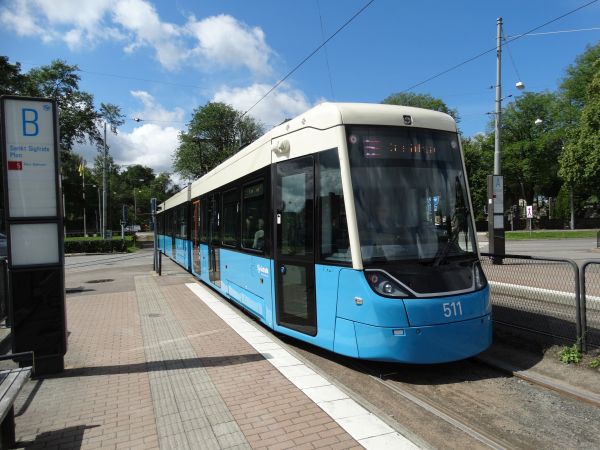
Another type 33A tram arriving at the tramstop Sankt Sigfrids Plan.
Picture by Ilkka Siissalo 7.7.2023.
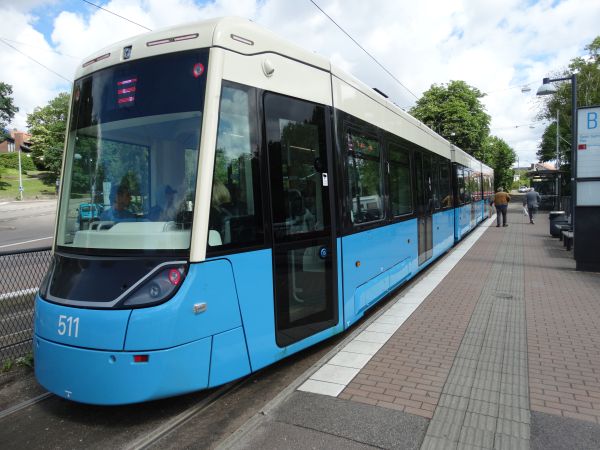
Although the type 33A is not planned to be used in two directions, the back of the tram nevertheless looks very much
the same as the front.
Picture from Sankt Sigfrids Plan by Ilkka Siissalo 7.7.2023.
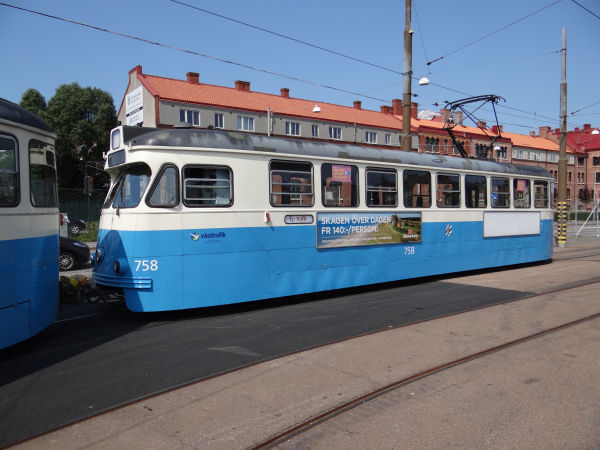
One of Göteborg's old so called "pedalvagnar" of the class M28 built by ASJL and Asea 1965-67. The design is heavily based
on a 1930s US design. Those US trams were given very cheaply as part of the Marshall aid programme throughout Europe after
the second world war. These M28s are not exactly similar to the US ones, but are clearly derived out of them.
Picture by Ilkka Siissalo 12.7.2013.
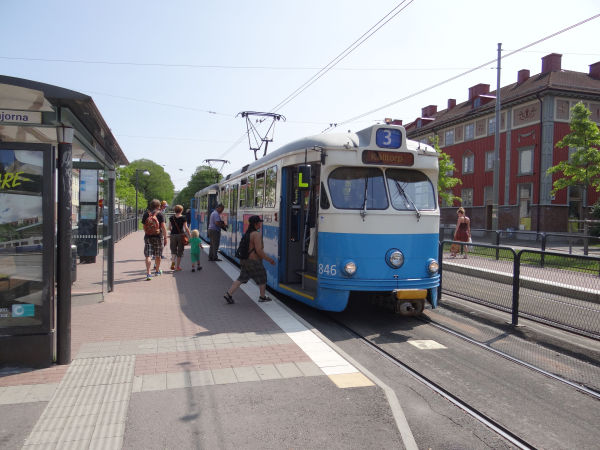
Two of Göteborg's class M28 and M29 trams driving in tandem on line 3, with an M29 in front. The M29s are almost, but not
quite similar to the M28s shown above. The M29 was built by Hägglunds 1969-72 and the design was already then badly outdated.
Picture by Ilkka Siissalo 12.7.2013.
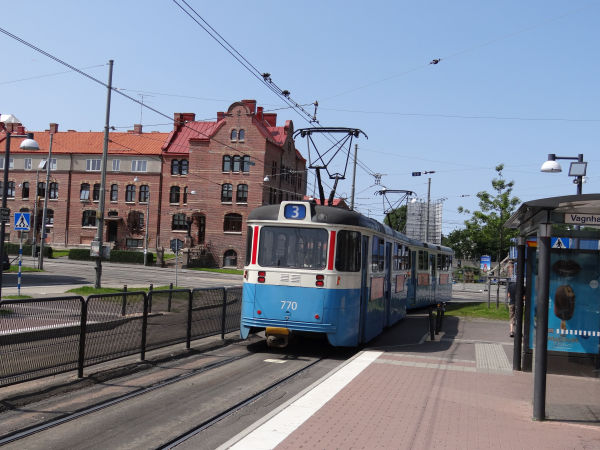
The same two trams as above. Nr 770 at the back is a class M28 and the one leading is an M29.
Picture by Ilkka Siissalo 12.7.2013.
Lisebergslinjen & Göteborg's tram museum
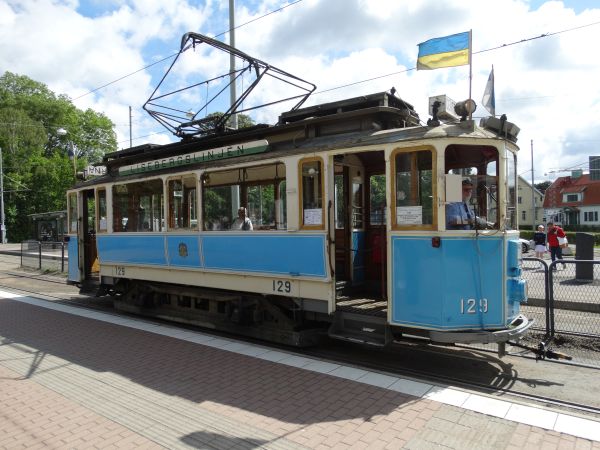
There is an active association called Spårvägssällskapet Ringlinien (tram line association Ringline) which in cooperation with Göteborg's spårvägar
(Gothen burg city's trams system) and its operator company Västtrafiken takes care of the tram museum of the city and also during the summer runs
a short tramline no.12, the Lisebergslinjen, from Göteborg's central station to Liseberg where the line ends at St Sigfrids Plats. The line is
operated by different historic trams and by personnel who are voluntary, typically retired tram peronnel of Västtrafiken.
This tram is a typical 1920s tram type built by Asea which used to be called "The little Swede". It was a very common type, used also e.g. in
Stockholm and in Finland, Helsinki.
Picture by the tramstop St.Sigfrids Plan by Ilkka Siissalo 7.7.2023.
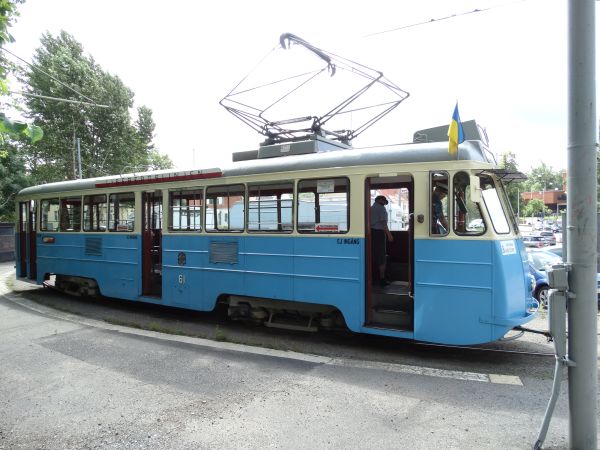
Lisebergslinjen's tram 61 is a so called Mustang tram. These wagons were not originally native to Göteborg although they were commonly used in other
cities including Stockholm. This tram was built by Hägglund's in 1953 for use in Gävle and it was sold to Göteborg in 1956 when it was still quite new.
There were only three of these Mustang wagons that came to Göteborg at the time when tram traffic in Gävle was ended.
Picture by the tramstop St.Sigfrids Plan by Ilkka Siissalo 7.7.2023.
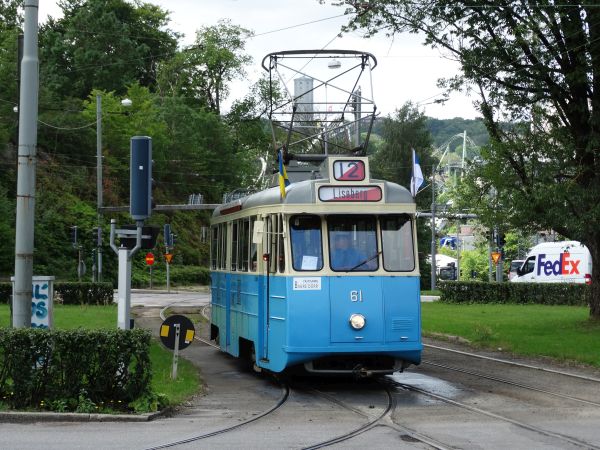
The same Mustang tram no.61 seen from its front.
Picture by the tramstop St.Sigfrids Plan by Ilkka Siissalo 7.7.2023.

